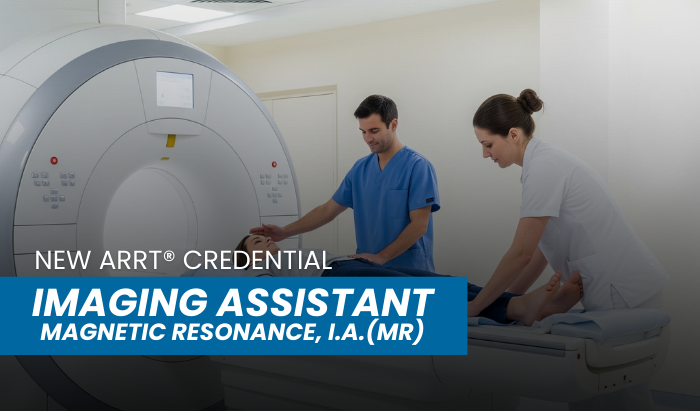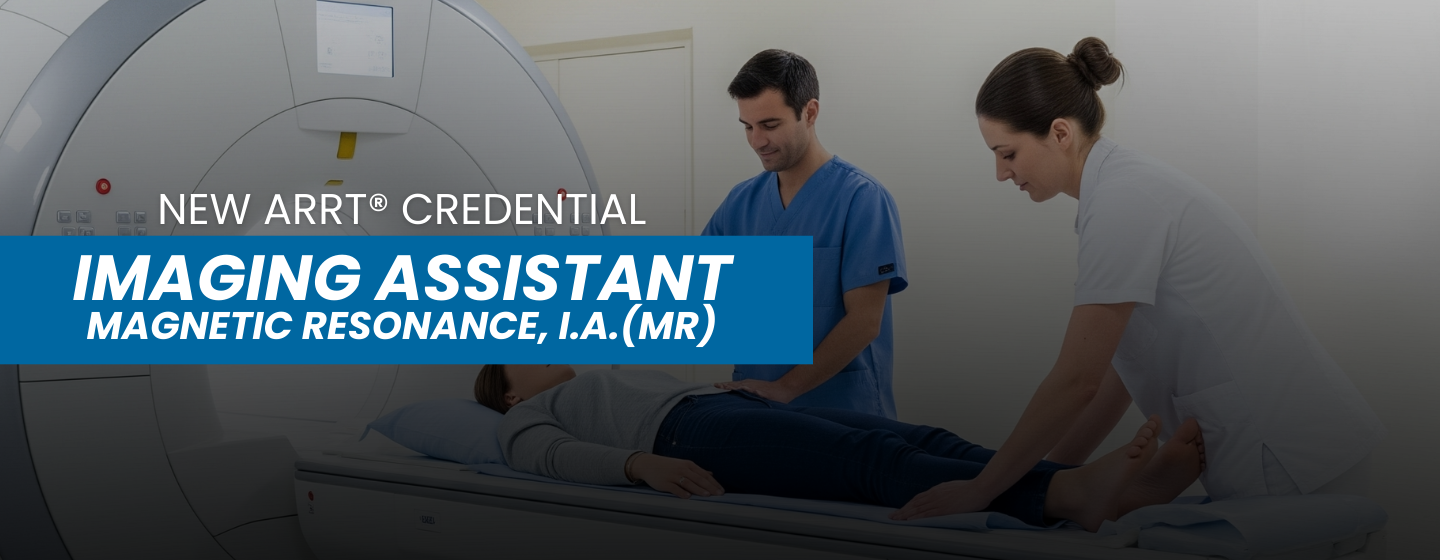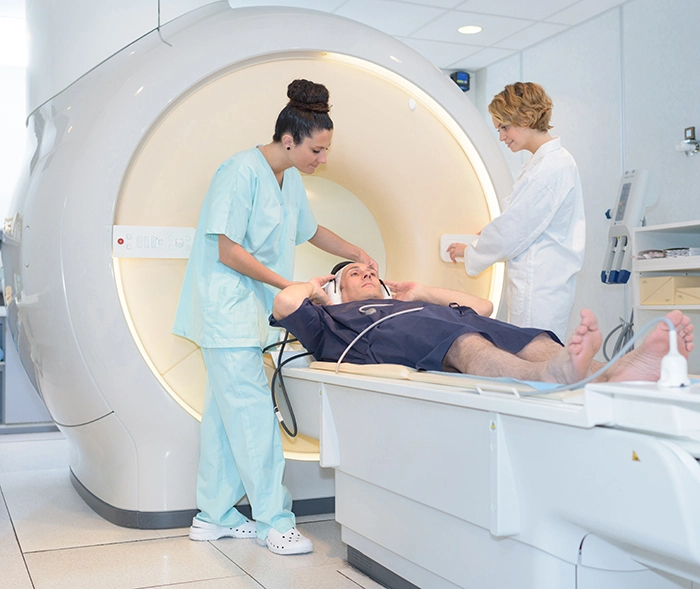Your Guide to The New ARRT® Imaging Assistant, Magnetic Resonance (I.A.(MR)) Credential



Step-by-Step Path to Certification
- Overview: What Is the Imaging Assistant, MR Credential?
- Why It Matters: The Role of Imaging Assistants
- Step 1: Are You Eligible?
- Step 2: Complete Structured Education (SE)
- Step 3: Fulfill Clinical Experience Requirements
- Step 4: Apply and Take the Exam
- Step 5: Maintain Your Credential (CE + CQR)
- Timeline Checklist
- Tips for Success
- Additional Resources
Overview: What Is the Imaging Assistant, MR Credential?
The American Registry of Radiologic Technologists (ARRT®) has added the Imaging Assistant, MR (I.A.(MR)) credential to its list of diagnostic medical tech credentials. The new credential will certify imaging technologist assistants and professionals who support MR technologists in non-diagnostic scanning procedures, safety-sensitive roles.
Why It Matters: The Role of Imaging Assistants

Core Responsibilities of the Imaging Assistants, MR:
Patient Interaction & Support: Greeting patients, explaining the procedure, answering questions, and ensuring patients feel comfortable before entering the MR environment.
MRI Safety Screening: Conducting thorough safety questionnaires, identifying potential contraindications (implants, devices, metallic objects), and escalating findings to the supervising MR technologist.
Preparation & Positioning Assistance: Helping patients onto the table, providing immobilization aids, and assisting with anatomical landmarking under direct technologist supervision.
Contrast Procedure Support: Preparing necessary materials for contrast administration, ensuring IV supplies are ready, and following aseptic protocols (note: I.A. does not inject contrast).
Workflow Efficiency: Managing patient flow between Zones II, III, and IV, reducing downtime between scans.
Environmental Readiness: Maintaining a safe, clean, and organized MR suite, including checking ferromagnetic safety compliance on hospital equipment.
With the I.A.(MR) credential, ARRT® is adding standardized training and recognition to this important role, and a recognized career pathway:
- Professional credibility: Formal recognition of your skills in MRI safety, patient care, and positioning.
- Skill development: Structured education and clinical training to advance in medical imaging.
- Growth opportunities: While the Imaging Assistant, MR (I.A.(MR)) credential is not a direct first step to becoming an MRI technologist, it offers valuable exposure and hands-on experience in an MRI environment, offering a deeper insight into the field and preparing individuals better than those who start their studies without prior experience in a radiology department.
Step 1: Are You Eligible?
You can apply for the Imaging Assistant, MR (I.A.(MR)) credential if you meet all of the following:

| Requirement | Details |
|---|---|
| Age | You must be at least 18 years old. |
| Education | High school diploma or GED required |
| Ethics | No unresolved ethics violations with ARRT® – review ARRT®’s ethical requirements before starting. |
| Training Window | All structured education (SE) and clinical experience must be completed within the 24 months immediately before you apply. (We will be discussing SE and clinical hours in the upcoming steps below) |
Important note:
- Remote observations or virtual tasks do not count; you must be physically present in the MR environment.
- If you’re not sure about your eligibility, confirm with ARRT® before enrolling in courses.
Pro Tip:
Getting clarity now prevents surprises later, especially with ethics requirements. If you’ve had any previous issues, resolve them before you invest in education or clinical hours.
Step 2: Complete Structured Education (SE)
Once you confirm you’re eligible, your next step is to complete Structured Education (SE), which covers the essential duties of the Imaging Assistant, MR role. Whether you’re working as a medical imaging assistant, employed as a diagnostic imaging assistant in an outpatient center, or gaining experience as an imaging technologist assistant in a hospital MRI unit, these SE requirements are mandatory for everyone.
What Counts as SE?
Structured education activities must be either:
- Category A or A+ CE activities approved by an ARRT®-Recognized Continuing Education Evaluation Mechanism (RCEEM), (for example: ASRT®)
- Academic courses from institutions recognized by ARRT®
- 1 semester credit = 16 CE credits
- 1 quarter credit = 12 CE credits
OR
You can mix and match continuing education (CE) and academic credit. If you’re using college coursework.
Required CE Credits:
To fulfill you structured education requirements, you would need to acquire a certain number of CE credits based on the following criteria
| Content Category | Without a Prerequisite Credential | With a Prerequisite Medical Credential |
|---|---|---|
| Patient Care Patient Interactions & Management |
8 CE credits (1 credit must be in ethics) |
1 CE credit |
| Safety MRI Screening and Safety |
12 CE credits | 12 CE credits |
| Positioning and Anatomical Landmarking Neurological, Body, Musculoskeletal |
8 CE credits | 4 CE credits |
| Additional CE Credits (any content area) |
4 CE credits | – |
| Total | 32 CE credits | 17 CE credits |
What Is a “Prerequisite Medical Credential”?
If you already hold a valid medical credential recognized by ARRT®, like radiologic technologist (R.T.(R)), registered nurse (RN), or other certifications that require ongoing maintenance, you may qualify for a credit reduction. Ongoing maintenance or requirements mean continuing education, or continuing medical education (CE/CME).
- ARRT® allows up to 15 CE credits to be waived based on your credential.
- This reduces your total SE requirement from 32 to 17 CE credits.
- However, the 12 credits in MRI Safety are mandatory for everyone, regardless of background.
To receive this reduction, you must:
- Submit proof of your current credentials when applying
- Have your credentials approved by ARRT®
Notes on Structured Education (SE) Requirements:
- All CE must be MRI-relevant and match the Imaging Assistant, MR (I.A.(MR)) content specifications
- Courses must be completed before applying for the credential
- If you’re using academic coursework, be sure it aligns with the Structured Education content outline published by ARRT®
- The 4 “Additional CE Credits” (for those without credentials) can come from any of the required content areas: patient care, safety, or positioning
See the official ARRT®’s structured education requirements for I.A. (MR) here.
Step 3: Fulfill Clinical Experience Requirements
Alongside your Structured Education, you’ll need to complete hands-on clinical experience requirements. Whether you support MRI operations as a medical imaging assistant, contribute as a diagnostic imaging assistant, or train as an imaging technologist assistant under an R.T.’s supervision, you’ll follow the same process for completing your clinical experience.
- Patient screening for MR safety
- Applying safety protocols (Zone II to IV)
- Assisting in contrast procedure setup (not injecting)
- Positioning under R.T. supervision
- Helping patients with comfort during the exam

Logging Instructions:
- Use ARRT®’s online Clinical Experience Tool
- Must log each task performed
- Require supervision by a certified R.T. (direct or live video)
Daily Limits:
- Max 7 entries per day
- Designed to encourage spaced learning
You must:
- Complete tasks in person
- Finish logging within 24 months of application
Your R.T. verifier must review and electronically sign off on each entry.
Learn more about ARRT® clinical competency requirements for an I.A. (MR) here.
Step 4: Apply and Take the Exam
From medical imaging assistants in small clinics to diagnostic imaging assistants in major hospitals and imaging technologist assistants working alongside R.T.s, all candidates go through the same I.A.(MR) exam process.

The I.A.(MR) exam consists of 100 scored multiple-choice questions across 3 major domains, plus an additional 20 unscored pilot questions (pilot questions are found in all ARRT® registry exams). The test focuses on three core content categories aligned with the structured education and clinical tasks.
| Domain | Topics Covered | Number of Scored Questions* |
|---|---|---|
| Patient Care | Patient Interactions and Management | 31 |
| Safety | MRI Screening and Safety | 37 |
| Positioning and Landmarks | Neurological (10) Body (10) Musculoskeletal (12) |
32 |
| TOTAL | 100 | |
- First exam administration: Fall 2026 – Join ARRT® I.A.(MR)’s mailing list to stay up to date on exam windows!
- Format: Computer-based, multiple-choice
- Passing score: Determined by ARRT®’s standard-setting methods
Study Tip: Use the SE content and clinical tasks as your study guide; there’s no new material beyond what you’ll already learn hands-on. You’ll be tested on the same core categories required in Structured Education: Patient Care, MRI Safety, and Positioning. If you’re using the reduced 17-credit pathway (with a prior credential), remember that MRI Safety remains a major focus on the exam.
Step 5: Maintain Your Credential (CE + CQR)
(Continuing Education + Continuing Qualification Requirements)
Earning your Imaging Assistant, MR (I.A.(MR)) credential is just the beginning. Whether you’re a medical imaging assistant in a busy hospital, a diagnostic imaging assistant in an outpatient MRI center, or an imaging technologist assistant working alongside registered technologists, keeping your credential active requires ongoing education and compliance.
Annual Credential Renewal Requirements
To maintain your ARRT® Imaging Assistant credential, you must renew your certification every year. Here’s what you need to know:
- Due every year on the last day of your birth month
- Renew via the ARRT® online portal
- The annual renewal process requires you to confirm your compliance with ARRT®’s ethical and professional standards and submit the required annual renewal fee (current fee is $30 for the first credential and $15 for additional credentials).
Read more about annual renewal and fees here.
Biennial Continuing Education (CE) Requirement
In addition to your annual renewal, you must complete Continuing Education (CE) requirements every two years:
- 10 CE credits related to I.A.(MR) topics
- The CE credits must be earned every 2 years, in addition to the 24 CE credits required for those with ARRT® credentials, such as registered Technologist (R.T.s).
Tip: Combine SE + CE when possible. For example, a 10-credit MR safety course can fulfill both your Structured Education requirement (if applying) and biennial CE requirement (if renewing), as long as it’s completed within the required timeframe and approved by an ARRT®-recognized provider.
10-Year Continuing Qualifications Requirement (CQR):
At your 10-year mark:
- Take a Professional Profile to identify weak areas
- Complete an SSA (Structured Self-Assessment)
- Finish any prescribed CE if knowledge gaps are found
CQR window stays open for 3 years.
Note on CQR: CQR is mandatory for all credentials earned after 2011.
If you’re pursuing the Imaging Assistant, MR (I.A.(MR)) credential, whether you currently work in medical imaging, diagnostic imaging, or assist MRI technologists in a clinical setting, this timeline will guide you through each step from start to finish.
| Task | Timeframe |
| Begin SE | Immediately |
| Begin clinical logging | As soon as eligible |
| Complete SE | Within 24 months of application |
| Complete clinical tasks | Within 24 months of application |
| Apply for the exam | When ARRT® opens the portal (Fall 2026) |
| Pass I.A.(MR) exam | Before the expiration of eligibility |
| Renew annually | Every birth month |
| Complete CE | Every 2 years |
| Complete CQR | Every 10 years |
Tips for Success
From those just starting as a medical imaging assistant to experienced professionals working in diagnostic imaging or assisting MRI technologists, these tips will help you earn the I.A.(MR) credential and keep it active with confidence.
- Start SE and clinical tasks early, give yourself the full 24-month window
- Use ARRT®’s online tools for clinical logging and document tracking
- Work closely with an R.T., they’ll verify your competency
- Choose quality CE/SE providers, make sure they’re ARRT®-approved (Check out our variety of CE/SE courses).
- Keep all certificates and documentation for 5+ years, in case of an audit (read more about CE audits here)
- Track your CE on a calendar, CE gets hectic near renewal dates!
